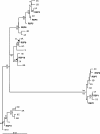Role of migratory birds in introduction and range expansion of Ixodes scapularis ticks and of Borrelia burgdorferi and Anaplasma phagocytophilum in Canada
- PMID: 18245258
- PMCID: PMC2268299
- DOI: 10.1128/AEM.01982-07
Role of migratory birds in introduction and range expansion of Ixodes scapularis ticks and of Borrelia burgdorferi and Anaplasma phagocytophilum in Canada
Erratum in
- Appl Environ Microbiol. 2008 Jun;74(12):3919
Abstract
During the spring in 2005 and 2006, 39,095 northward-migrating land birds were captured at 12 bird observatories in eastern Canada to investigate the role of migratory birds in northward range expansion of Lyme borreliosis, human granulocytic anaplasmosis, and their tick vector, Ixodes scapularis. The prevalence of birds carrying I. scapularis ticks (mostly nymphs) was 0.35% (95% confidence interval [CI] = 0.30 to 0.42), but a nested study by experienced observers suggested a more realistic infestation prevalence of 2.2% (95% CI = 1.18 to 3.73). The mean infestation intensity was 1.66 per bird. Overall, 15.4% of I. scapularis nymphs (95% CI = 10.7 to 20.9) were PCR positive for Borrelia burgdorferi, but only 8% (95% CI = 3.8 to 15.1) were positive when excluding nymphs collected at Long Point, Ontario, where B. burgdorferi is endemic. A wide range of ospC and rrs-rrl intergenic spacer alleles of B. burgdorferi were identified in infected ticks, including those associated with disseminated Lyme disease and alleles that are rare in the northeastern United States. Overall, 1.4[corrected]% (95% CI = 0.3 [corrected] to 0.41) of I. scapularis nymphs were PCR positive for Anaplasma phagocytophilum. We estimate that migratory birds disperse 50 million to 175 million I. scapularis ticks across Canada each spring, implicating migratory birds as possibly significant in I. scapularis range expansion in Canada. However, infrequent larvae and the low infection prevalence in ticks carried by the birds raise questions as to how B. burgdorferi and A. phagocytophilum become endemic in any tick populations established by bird-transported ticks.
Figures


References
-
- Adelson, M. E., R. V. Rao, R. C. Tilton, K. Cabets, E. Eskow, L. Fein, J. L. Occi, and E. Mordechai. 2004. Prevalence of Borrelia burgdorferi, Bartonella spp., Babesia microti, and Anaplasma phagocytophila in Ixodes scapularis ticks collected in Northern New Jersey. J. Clin. Microbiol. 42:2799-2781. - PMC - PubMed
-
- Barker, I. K., G. A. Surgeoner, H. Artsob, S. A. McEwen, L. A. Elliott, G. D. Campbell, and J. T. Robinson. 1992. Distribution of the Lyme disease vector, Ixodes dammini (Acari: Ixodidae) and isolation of Borrelia burgdorferi in Ontario, Canada. J. Med. Entomol. 29:1011-1022. - PubMed
-
- Battaly, G. R., and D. Fish. 1993. Relative importance of bird species as hosts for immature Ixodes dammini (Acari: Ixodidae) in a suburban residential landscape of southern New York State. J. Med. Entomol. 30:740-747. - PubMed
Publication types
MeSH terms
Substances
Associated data
- Actions
- Actions
- Actions
- Actions
- Actions
- Actions
- Actions
- Actions
- Actions
- Actions
- Actions
- Actions
- Actions
- Actions
- Actions
- Actions
- Actions
- Actions
- Actions
- Actions
- Actions
- Actions
- Actions
- Actions
- Actions
- Actions
- Actions
- Actions
- Actions
Grants and funding
LinkOut - more resources
Full Text Sources

